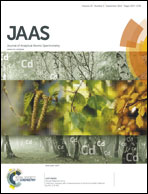Diode laser thermal vaporization ICP MS with a simple tubular cell for determination of lead and cadmium in whole blood
Abstract
A new low-cost device suitable for the recently presented sample introduction technique to inductively coupled plasma mass spectrometry (ICP MS), diode laser thermal vaporization (DLTV), is described. DLTV ICP MS is suitable for quantitative elemental analysis of low volume liquid samples and offers an alternative to commonly used liquid sample introduction into inductively coupled plasma. In contrast to the existing sample introduction systems based on laser ablation, the technique relies on low-cost components: a diode laser, a simple laboratory-built cell and a strip of filter paper. The aerosol generation by DLTV is carried out in a simple cell made up of a glass tube, a near infrared continuous-wave diode laser and a common syringe pump. The cell is characterized by minimal dead volume, which reduces turbulent flow and provides very fast wash-out. The paper substrate can hold up to 24 samples; an analysis time per sample of ∼4.7 s has been achieved. The device performance was optimized, compared to a commercial ablation system and applied to the determination of lead and cadmium in whole human blood without any sample treatment. A prearranged calibration set was printed on the paper strip using a piezoelectric dispenser.


 Please wait while we load your content...
Please wait while we load your content...